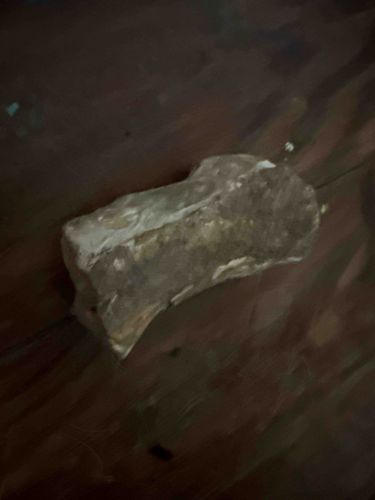
Unidentified Bone/Fossil Fragment
The item appears to be an elongated, irregularly shaped fragment, likely composed of bone or fossilized material, resting on a dark, possibly wooden, surface. Its primary coloration is a mottled light grey to off-white, suggesting some degree of weathering, mineralization, or perhaps a natural outer layer that differs from its core. There is a distinct section on one side that exhibits a darker, earthy brown or grey hue, potentially revealing the internal structure of the material or indicating an area where the lighter outer layer has chipped away. The texture seems rough and uneven, with various ridges, depressions, and sharp angles indicative of a natural breakage rather than intentional shaping. Portions of the surface show a somewhat smoother, almost polished appearance in certain areas, contrasted with crumbly or coarse textures elsewhere. The fragment is not symmetrical and lacks any discernible markings, carvings, or signs of human alteration. Given its amorphous nature and coloration, it could be a fragment of a larger bone, a fossilized bone, or even a naturally occurring rock with bone-like characteristics. There are no immediate visible signs of repair, though the natural breakage points are quite apparent. The piece is likely ancient or at least very old, given its weathered appearance and potential for fossilization, making it difficult to pinpoint a specific style period without further scientific analysis. Its unique aspect lies in its undefined nature, making its specific origin and composition a subject of further investigation. The quality indicators are based purely on natural formation, with no human craftsmanship evident.
AI-Generated Appraisal Disclaimer
Estimated Value
$10 - $30
Basic Information
Category
Natural Specimen
Appraised On
November 29, 2025
Estimated Value
$10 - $30
Item Description
The item appears to be an elongated, irregularly shaped fragment, likely composed of bone or fossilized material, resting on a dark, possibly wooden, surface. Its primary coloration is a mottled light grey to off-white, suggesting some degree of weathering, mineralization, or perhaps a natural outer layer that differs from its core. There is a distinct section on one side that exhibits a darker, earthy brown or grey hue, potentially revealing the internal structure of the material or indicating an area where the lighter outer layer has chipped away. The texture seems rough and uneven, with various ridges, depressions, and sharp angles indicative of a natural breakage rather than intentional shaping. Portions of the surface show a somewhat smoother, almost polished appearance in certain areas, contrasted with crumbly or coarse textures elsewhere. The fragment is not symmetrical and lacks any discernible markings, carvings, or signs of human alteration. Given its amorphous nature and coloration, it could be a fragment of a larger bone, a fossilized bone, or even a naturally occurring rock with bone-like characteristics. There are no immediate visible signs of repair, though the natural breakage points are quite apparent. The piece is likely ancient or at least very old, given its weathered appearance and potential for fossilization, making it difficult to pinpoint a specific style period without further scientific analysis. Its unique aspect lies in its undefined nature, making its specific origin and composition a subject of further investigation. The quality indicators are based purely on natural formation, with no human craftsmanship evident.
Get Your Items Appraised
Instant estimates of your treasures with AI-powered instant appraisals